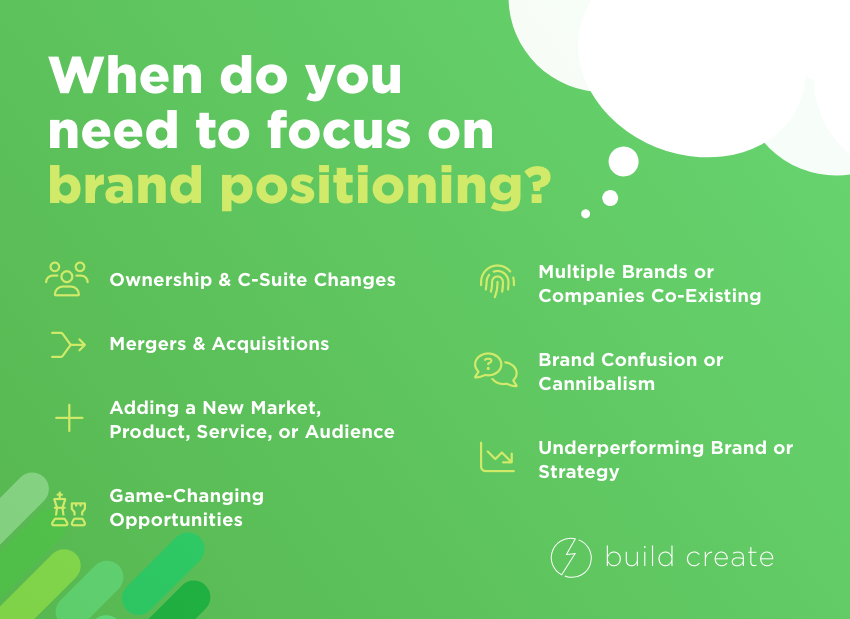Brand positioning brings essential clarity during major inflection points in your business.
Brand positioning clarifies who you are today, what you stand for, who you serve, and where you want to go as a business. As your organization evolves, people come and go, trends and technology change, acquisitions happen, and eventually you start to lose your grip on the core brand identity and values that were originally driving the business and marketing strategy.
When these changes occur, focus shifts, and you risk jeopardizing your hard-won position in your audience’s minds. It’s time to take a long look at how to win back—or prevent losing—that rapport and familiarity.
When should you focus on redefining your brand positioning, identity, and marketing strategy?
Positioning, branding, and marketing are how your business shows up in the world, and as time goes by it’s often critical to revisit them to ensure that they remain in alignment. Based on our experience with our marketing clients in the manufacturing and technology industries, these key inflection points in a business’s growth and marketing success warrant revisiting your positioning strategy:
- Ownership & C-Suite Changes
- Mergers & Acquisitions
- Multiple Brands or Companies Co-Existing
- Brand Confusion or Cannibalism
- Adding a New Market, Product, Service, or Audience
- Game-Changing Opportunities
- Underperforming Brand or Strategy
Each of these brings their own unique strategic and tactical considerations to the table. We’ll dig into some of these to help frame your thinking as you consider whether brand and market positioning work is the right move.
Brand positioning brings sales, marketing, and leadership into alignment with company goals and culture.
As companies mature and scale, a lot of moving parts can fall out of sync, especially when changes occur with ownership, department heads, or the C-suite. These transitional moments also offer the opportunity for reflection on what’s working, and what’s not working. This is where strategic planning is critical, including a review of the company’s brand strength and market positioning.
Ownership, C-Suite, and Department Head Changes
When leadership changes, new leaders bring in new perspectives, new vision, and often new priorities. Sometimes this change can be revolutionary to a business, and sometimes not so much. New leadership may want to move products and services up-market, or they may be more or less focused on marketing than the old guard. Brand positioning work can help integrate new leadership and their experience into company values and culture, and ensure that how you show up in the world is in alignment with your values and goals.
Mergers & Acquisitions
When one company is absorbed into another, the overall identity of this new organization enters a period of flux. Existing and new customers for both companies may suddenly find themselves in a confusing position: who do I go to for help? Will the new owners maintain the same level of service I’m accustomed to? This is your opportunity to fully claim the mental real estate of both brands in your audiences’ minds by firmly re-establishing your brand position through reiterating your value proposition and competitive advantage.

Multiple Brands or Companies Co-Existing
After a series of mergers and/or acquisitions, businesses are left with a collection of brands and company structures that can lead to extreme confusion for your customers. Everything from positioning all the way down to website design and architecture should be considered at this juncture to ensure that there is clarity about which brand or company is relevant to each audience.
Brand Confusion or Cannibalism
As a byproduct of the previous two circumstances, you can be left with a confusing array of brands you’re trying to support—especially in the case of an acquisition, where trying to maintain multiple brands may create internal competition with brands cannibalizing one another. This is when we want to look at consolidating brands to create a unified position around fewer brands, or even a single brand, so that you aren’t competing against yourself and confusing your audience.

Adding a New Market, Product, Service, or Audience
This is the most straightforward, intuitive circumstance in which you’ll want to rethink your positioning. Whenever you’re doing something new, you want people to know about it, and to think about it in the way you want them to. Moreover, depending on how big the new addition is, it may warrant revisiting branding, marketing, and collateral as well to highlight your new initiatives. When you are aiming for a new audience, doing a full competitive analysis as part of your brand positioning work will be key to ensuring that your marketing strategy is informed, and that it’s speaking to the right people at the right time.
Game-Changing Opportunities
Sometimes something new arises that catalyzes big changes in the business. This could be new technology (think new automotive battery technology for EVs) that creates either an opportunity or a threat to the status quo. As your business pivots and adapts to this market disruption, re-evaluating or reinforcing how this aligns with your brand values and market position is key to ensure that you are speaking to the right audience, and building the right connections.
Underperforming Brand or Strategy
An underperforming brand or strategy is often uncovered during key staff or leadership changes. Usually this is caused by stagnant marketing efforts, or a marketing team that has been stymied by a myopic focus on direct sales. Sometimes, due to the nature of manufacturing (especially automotive manufacturing), branding and marketing haven’t ever been priorities because business was coming in regardless. But as the business evolves, brand positioning grows in importance as recognition, prestige, and even talent attraction/retention become priorities.
Your audience should be left with no doubts about who you are, what you do, and why they should work with you.
At every step along the way, make sure you have a clear answer to those questions. As changes arise, businesses evolve, and markets shift, be a vigilant guardian of your brand and its position in the mind of your audience. Consistency is key, and reliability is reassurance—which morphs into trust and equity over time.
Keeping your positioning and brand strategy current and consistent is a boon to your audience, who in turn will reward your efforts by becoming long-term customers whose values resonate with your own.







